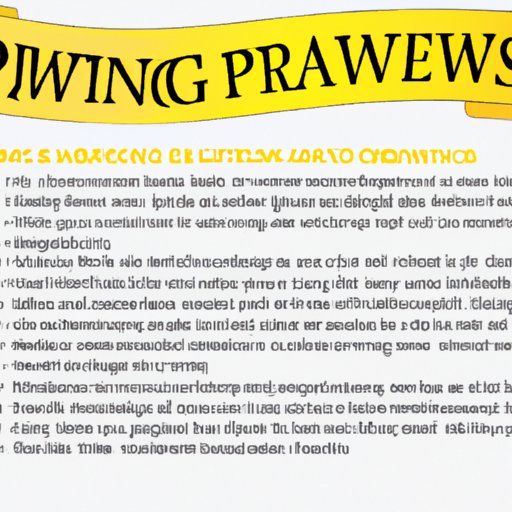Introduction
Pawning is a centuries-old practice of obtaining funds by using personal property as collateral in exchange for a loan. It’s a fast and easy way to get some extra cash when you need it. But how exactly does it work? In this article, we’ll explore the pawning process step-by-step, so you know what to expect when going to a pawn shop.
Definition of Pawning
Pawning is a form of secured lending. You bring items of value to a pawn shop, and the shop owner will offer you a loan in exchange for your items. The loan amount is based on the estimated value of the item, and the loan is typically short-term, with repayment due within 30 days. If you don’t repay the loan, the shop keeps the item as payment.

Overview of the Benefits and Drawbacks of Pawning
Pawning has its advantages and disadvantages. On the plus side, you get quick cash without a credit check or lengthy application process. According to a study from the University of Michigan, “[pawn] stores provide access to credit to those with few other options, such as those who are unbanked or underbanked.” Additionally, pawn shops are regulated by state laws, so you can be sure that you’re dealing with a reputable business.
On the downside, you’re putting up your valuable items as collateral, so there’s always the risk of losing them if you don’t pay back the loan. Plus, the interest rates on pawn loans are typically high. As the National Consumer Law Center notes, “The annual percentage rate (APR) for pawn loans is often in the triple digits.”
Step-by-Step Process of Pawning
If you decide that pawning is right for you, here’s what you can expect:
Locating a Reputable Pawn Shop
The first step is to find a pawn shop that you trust and feel comfortable doing business with. Look for a shop that’s been in business for at least several years and has good reviews online. Ask around to see if anyone you know has used the shop before and get their opinion.
Establishing Terms and Conditions of the Loan
Once you’ve chosen a shop, you’ll need to establish the terms and conditions of the loan. This includes the loan amount, repayment date, and the interest rate. Make sure to ask plenty of questions and read all the paperwork carefully. Don’t be afraid to negotiate the terms of the loan to get the best deal possible.
Presenting Items Accepted for Pawning
Next, you’ll need to present the items that you want to use as collateral for the loan. Most pawn shops accept jewelry, electronics, tools, musical instruments, and antiques. However, each shop may have different restrictions, so check with them beforehand.
Completing the Transaction
Finally, you’ll complete the transaction. The pawnbroker will inspect the item(s) and determine its value. Then, they’ll give you the loan amount minus any applicable fees. You’ll receive the money in cash and sign a contract stating the terms and conditions of the loan.
Differences Between Pawning vs. Selling
When deciding whether to pawn or sell an item, it’s important to understand the pros and cons of each option. With pawning, you get quick cash in exchange for your item. However, you’re putting up your item as collateral, which means that you could lose it if you don’t repay the loan. With selling, you get cash upfront, but the amount you receive may be less than what you’d get from a pawn shop.

Tips for Getting the Best Deal When Pawning
To get the best deal when pawning, follow these tips:
Researching Prices
Before going to a pawn shop, do some research to get an idea of the price range for the items you’re pawning. You can use websites like eBay and Craigslist to get an estimate of the current market value.
Negotiating Terms
When you’re at the pawn shop, negotiate the terms of the loan. Don’t be afraid to haggle to get the best deal possible. Remember that the pawnbroker is in the business of making money, so you should try to get the lowest interest rate and longest repayment period that you can.
Comparing Options
Finally, compare options. If you’re not happy with the terms offered by one shop, shop around until you find one that meets your needs. There are many pawn shops out there, so take your time and make sure you get the best deal.
Conclusion
Pawning is a great way to get quick cash when you need it. But it’s important to understand the process and know what to expect. Follow the steps outlined in this article, do your research, and negotiate the best deal possible. With the right approach, you can get the money you need without putting yourself at risk.
(Note: Is this article not meeting your expectations? Do you have knowledge or insights to share? Unlock new opportunities and expand your reach by joining our authors team. Click Registration to join us and share your expertise with our readers.)
